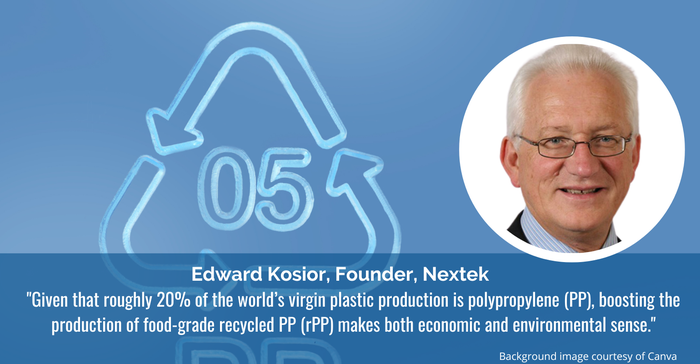Because 20% of the world’s virgin plastic production is polypropylene, increasing production of food-grade recycled PP makes economic and environmental sense.
September 12, 2022

Global consumer packaging waste continues to increase with little regard as to how to manage its end of life. Since the 1950s the world has produced around 8 billion tonnes/8.8 billion tons of plastic. We are certainly paying more attention to how we manage it, though a greater push to improving waste prevention and developing systems for packaging that enable reusability, recyclability, and recycled content is needed.
Achieving circular packaging requires industry and governments to take strategic action in creating effective systems for the collection, sorting, and recycling of post-consumer waste. For decades we have left the responsibility of dealing with an ever-increasing amount of non-recyclable and mismanaged waste to the market, communities, consumers, and ultimately, the environment itself.
Systemic change that advances the circular economy requires dealing with the entire life cycle of every material we produce.
There is no all-in-one solution to the plastic packaging challenge.
While some leading voices advocate for a cap on plastic production, we can’t ignore the fact that we depend on this valuable material for many positive solutions. Reducing food waste is one key example.
First we must identify the most valuable polymers.
Placing a cap on plastic production would have to be balanced with finding alternative solutions to bridge the plastics gap. This goes beyond exploring alternative materials to closing the loop on our current post-consumer material streams.
It starts with identifying those polymers that play the biggest positive role in reducing our wasteful habits.
Food-grade polypropylene (PP), which plays a vital role in protecting our food and therefore reducing our food waste, is one of these.

Identifying the missing link in plastics recycling.
As such being able to rely on an abundance of high-quality food-grade recycled resins would go a long way towards reducing our reliance on virgin PP.
According to ICIS Mechanical Recycling Supply Tracker, food-grade resins represent only 10% of the global annual capacity of recycled polymers of over 45 million tonnes/48.6 million tons. More than 20% is food-grade recycled PET (rPET) compared with just 3% food-grade polyolefins (PP and polyethylene).
Given that roughly 20% of the world’s virgin plastic production is PP, boosting the production of food-grade rPP makes both economic and environmental sense.
Mechanically recycling PP also means closing the loop on a valuable material that would be wasted if diverted to other end-of-life solutions with higher carbon footprints, such as waste-to-energy or chemical recycling.
Addressing rPP roadblocks.
What is the main roadblock to turn post-consumer PP packaging back into food-grade recycled PP? Meeting the stringent government food safety standards for food-grade recycled resins is undoubtably one of the biggest challenges. However, that can change when we introduce transformational recycling solutions.
Achieving high-quality food-grade PP resin requires eliminating all contaminants from post-consumer waste that could be harmful to human health. It must also be proven that the recycled material does not change the food composition, taste, or odor in an unacceptable way.
Until recently, this was not possible, hence the reliance on virgin plastics for food packaging. Now we have powerful new technologies to not only sort post-consumer packaging, but also effectively eliminate potential residues in the recycled plastics which would cause non-compliance with food safety standards.
The global multi-participant project, NextLooPP, has closed the loop on food-grade, post-consumer PP. Together with 47 global organizations and using Nextek’s unique technology, NextLooPP is trialing prototype food-grade recycled PP (FgrPP) and inert (INRTgrade) resins in injection molding, extrusion, and thermoformed package manufacturing.
The project’s aim is to ensure the safety of resins made in its unique process by conducting full-scale “challenge tests” that deliberately add a range of surrogate molecules to simulate the potential contamination of plastics materials. This is done at contaminant levels hundreds of times higher than typically found in the post-consumer stream. The rate of decontamination of the recycling process is measured.
NextLooPP has demonstrated that the process can remove any migratable materials to safe levels.

Reframing the science and possibilities.
Despite these technological advances, we still face the huge constraints of big-volume polyolefin recycling. This is precisely the time when we need to be accelerating the research and technology developments to make this a reality.
Scientists Roland Franz and Frank Welle, of Fraunhofer IVV, recently published a paper on this very topic in which they argue that while the obligatory precautionary principle of the European Food Safety Authority (EFSA) requires a conservative safety assessment. The paper notes that over-conservative safety factors calculated during the recycling and migration processes might significantly overestimate the safety risks of recycled plastics in packaging applications. That increases the estimates of the risks posed to consumers sans the significant improvements in collection, high performance sorting, and recycling/decontamination processes.
Franz and Welle believe this could pose high, if not insurmountable, barriers to the application of post-consumer recyclates for food packaging; this could create a stranglehold on recycled food-grade resins, especially polyolefins, and counteracting circular economy targets.
As Franz and Welle point out, consideration of the input levels of possible harmful contaminants in the recycling stream is a primary pillar in EFSA’s safety assessment framework. The statistical determination of such concentrations in washed flakes as raw input material for super-clean recycling is crucial.
They go on to say that it is obvious that this element is not a static figure and that these levels will change if different re-collection streams are used. Once re-collection streams are established, the input concentrations will be lower over time due to improvements in consumer behavior and to changes in the reduced use of hazardous chemicals.
However, such data are largely, and broadly, lacking.
Franz and Welle suggest a less conservative and more realistic safety evaluation starting with considering whether all parameters must represent the worst-case scenario. This is done by using the average recyclate amount in an application in the exposure scenario instead of 100%.
Currently, EFSA assumes the presence of genotoxic substances in the recycling feedstock even though genotoxic substances cannot be used in any goods placed on retail shelves. It continues to use over-estimative prediction models for the migration calculation when more accurate models are available.
These worst-case assumptions at every step make the overall evaluation extremely conservative.
Using data based on the modern recycling infrastructure and the latest recycling technologies, it is possible to better reframe the basic assumptions that regulatory bodies rely on. This could redefine the criteria for the safe approval of food-grade recycled resins and provide an added opportunity to reduce the production of virgin plastics.
Regulations in European are far stricter than in the US.
EFSA’s vital constraints on meeting food contact conditions are much stricter compared with similar standards set by the Food and Drug Administration (FDA) in the US.
The simplified approach taken by US FDA of setting a migration “threshold of regulation” at 0.5 parts-per-billion (ppb) has a built-in consideration of consumer exposure to food and packaging types.
However, EFSA’s end criteria on a case-by-case basis adds an extensive assessment burden for EFSA and recyclers. EFSA criteria states that the threshold for migration for bottled water with recycled PET is 0.1ppb — an analytical challenge without the use of overestimating migration modeling. Such analytical challenges and highly conservative assumptions have led to EFSA suggesting recycling processes may be safe.
Thankfully, due to cutting-edge advances in recycling technology including decontamination, specialized recycling processes are highly effective in delivering “super-cleaned” recycled plastics such as PET, high-density polyethylene (HDPE) and PP that have been positively reviewed by USFDA and issued with a Letter of Non-Objection (LON).
Nearly 50 FDA LNO’s have been issued since 2020 showing the speed of the assessment system, along with no in-market incidents which gives testament to a fit-for-purpose risk assessment process by FDA.
Next generation circular recycling technology.
Following successful trials late last year, NextLooPP is now aggregating numerous examples of products into an expansive catalog of results to demonstrate the suitability of the project’s FgrPP, PPristine, and INRT resins.
There is a selection of new-generation technology that recyclers will shortly have at their disposal. These range from fluorescent markers, artificial intelligence (AI), and decontamination techniques to game-changing technology to recycle polyolefin including low-density polyethylene (LDPE), linear low density PE films, which are commonly used for packaging both edible and non-edible goods.
These films, which play a key role in protecting and extending the shelf life of many foods, are currently missing from the recycling stream; in short, there has been no effective decontamination technology to turn them back into food-grade films.
COtooCLEAN is yet another Nextek multi-participant project that aims to fill this gap with a unique commercial process that can be integrated into mechanical recycling operations. This innovative process is based on super-critical carbon dioxide (CO2) combined with green co-solvents to remove oils, fats, and printing inks in one single step. It can effectively decontaminate polyolefin films back to food contact levels.
As 2030 deadlines loom for mandates and sustainability related pledges, companies need to source an abundance of high-quality food-grade recycled resins. This supply is highly limited, though we are confident these emerging new technologies will help ease the regulatory bottleneck.
While it is true that across-the-board investment is needed from collection systems to recycling capabilities to increase the global supply of recyclates needed to reach industry targets, equally vital is the review of the criteria around food safety regulations. This now has the opportunity to revitalize the entire recycling industry.
Reducing the production of new plastics over time will go a long way to increasing the value of plastics, boosting efforts to curb plastic pollution, and promoting the transition to a circular and sustainable economy. However, for maximum impact our efforts need to be coherent and coordinated across the entire plastics ecosystem.
Edward Kosior, PhD., has more than 45 years’ plastics recycling expertise, split between 23 years as an academic and 23 years working in the industry. Kosior has been instrumental in designing numerous modern recycling plants and has achieved a number of patented recycling breakthroughs. He founded Nextek in 2004 to provide consultancy services to assist in the strategic approaches to sustainable packaging.
About the Author(s)
You May Also Like




